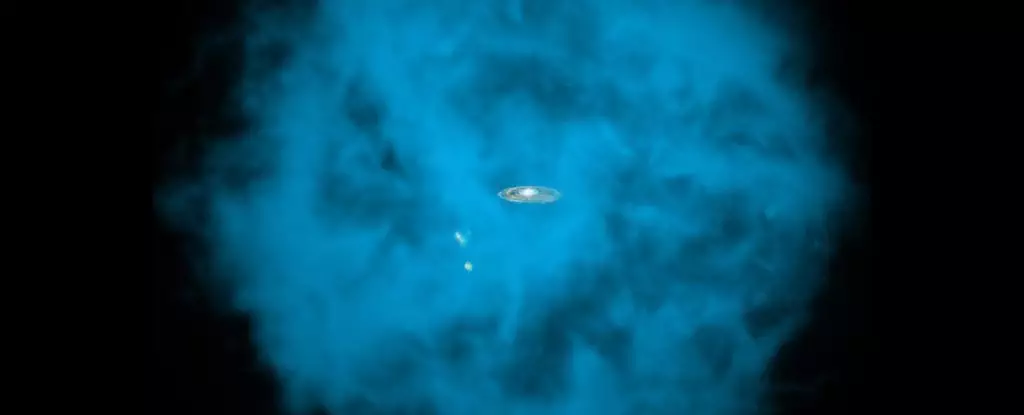For decades, the scientific community has grappled with one of astronomy’s most profound enigmas: the missing half of the Universe’s visible matter. Recent research has finally lifted the veil off this cosmic mystery, revealing that swathes of ionized hydrogen exist in vast, invisible clouds residing in the cosmic void surrounding galaxies. An extensive collaborative effort among an international team of astronomers and astrophysicists has led to breakthroughs in detection techniques, allowing scientists to isolate and study this elusive matter. What was once a frustrating puzzle has at last begun to coalesce into a clearer picture of our Universe.
At the heart of this discovery is a startling realization. Astronomers had long understood that ordinary baryonic matter constituted merely 5% of the Universe’s made-up composition, with dark matter (27%) and dark energy (68%) claiming the remainder. This stark divide compels us to confront a deeper question: where is all the missing baryonic matter hiding? With hydrogen representing roughly 90% of the Universe’s elemental makeup, a significant amount of this missing mass must also be hydrogen. Although detecting ionized hydrogen in the vastness of intergalactic space is complex, technological advances have finally led to observable confirmations of its existence.
Innovative Techniques to Unmask the Invisible
The challenge in identifying these intergalactic hydrogen clouds stems from their faint visibility. Ionized hydrogen can glow when exposed to radiation, but its presence is so diffuse amid sinister cosmic darkness that it remains elusive to standard observational techniques. To tackle this, researchers have begun employing a novel approach that utilizes the cosmic microwave background (CMB) as a means of uncovering these hidden areas. The CMB, often referred to as the ‘first light’ of the Universe, offers a backlight against which scientists can observe the effects of stray hydrogen.
The innovative technique adopted is known as the kinematic Sunyaev-Zel’dovich effect, which involves monitoring the fluctuations in the brightness of the CMB as it interacts with intergalactic gas. As this ancient light filters through ionized clouds, it experiences shifts in brightness, which reveal the presence and distribution of hydrogen. By stacking a multitude of observations—over a million glowing red galaxies within 8 billion light-years of the Milky Way—researchers managed to peel back the layers of obscurity surrounding the baryonic matter that has confounded astrophysicists for years.
The Implications of Expanded Hydrogen Haloes
The results of this ground-breaking work are both compelling and monumental. The discovery suggests that the hydrogen halo encircling galaxies is far larger than previously hypothesized. This revelation raises tantalizing questions about the nature of galaxy formation and the dynamics that outline the evolutionary processes of these colossal structures. Boryana Hadzhiyska from the University of California articulates the importance of recognizing that the further one probes into the distance from galaxies, the more one may uncover the gas that scientists have long thought was lost to the Universe.
This enigmatic relationship leads us to contemplate the complex interactions between hydrogen and supermassive black holes at the centers of galaxies. Such black holes can release powerful jets and winds that push gas particles away from galaxies, potentially stifling star formation. The newly discovered expansive haloes could imply that the activity of black holes is not consistent but intermittent—occasionally powering down and then surging back to life, mirroring certain trends noted in other observational studies. This adds yet another layer of complexity to our models of galaxy evolution.
Connecting the Dots: Baryons, Dark Matter, and Cosmic Evolution
It’s important to recognize that while this study provides an essential piece of the baryonic matter puzzle, it also invites further inquiry into how these missing baryons correlate with dark matter. Some portions of the unaccounted matter may indeed be entwined within the filaments of dark matter that form the grand cosmic web—a structure that connects galaxies across immense distances. By bridging the gap between baryonic and dark matter, this research paves the way for new directions in cosmological analysis, ultimately enriching our comprehension of the Universe’s formation.
The prospects opened by this research beget an air of excitement among astronomers, as they prepare to delve deeper into the intricacies of galactic archaeology. Uncovering the relationship between absent gas and dark matter not only enhances our understanding of the Universe’s past but also propels us toward future revelations. While the investigation of baryonic matter may have taken decades, science’s relentless pursuit now stands on the brink of understanding phenomena that can redefine our cosmic narratives.

